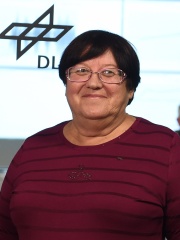
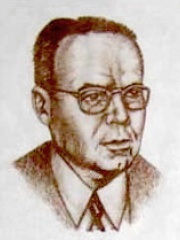

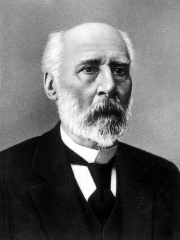
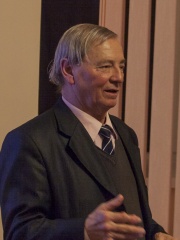
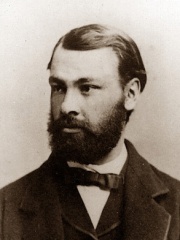

The Most Famous
ASTRONOMERS from Ukraine
This page contains a list of the greatest Ukrainian Astronomers. The pantheon dataset contains 644 Astronomers, 8 of which were born in Ukraine. This makes Ukraine the birth place of the 17th most number of Astronomers behind Türkiye, and Sweden.
Top 8
The following people are considered by Pantheon to be the most legendary Ukrainian Astronomers of all time. This list of famous Ukrainian Astronomers is sorted by HPI (Historical Popularity Index), a metric that aggregates information on a biography's online popularity.

1. Svetlana Gerasimenko (1945 - 2025)
With an HPI of 67.19, Svetlana Gerasimenko is the most famous Ukrainian Astronomer. Her biography has been translated into 36 different languages on wikipedia.
Svetlana Ivanovna Gerasimenko (Russian: Светлана Ивановна Герасименко; Ukrainian: Світлана Іванівна Герасименко; 23 February 1945 – 8 April 2025) was a Soviet and Tajikistani astronomer and discoverer of comet 67P/Churyumov–Gerasimenko.

2. Otto Struve (1897 - 1963)
With an HPI of 64.04, Otto Struve is the 2nd most famous Ukrainian Astronomer. His biography has been translated into 34 different languages.
Otto Lyudvigovich Struve (Russian: Отто Людвигович Струве; 12 August 1897 – 6 April 1963) was a Russian-American astronomer of Baltic German origin. Otto was the descendant of famous astronomers of the Struve family; he was the son of Ludwig Struve, grandson of Otto Wilhelm von Struve and great-grandson of Friedrich Georg Wilhelm von Struve. He was also the nephew of Karl Hermann Struve. With more than 900 journal articles and books, Struve was one of the most distinguished and prolific astronomers of the mid-20th century. He served as director of Yerkes, McDonald, Leuschner and National Radio Astronomy Observatories and is credited with raising worldwide prestige and building schools of talented scientists at Yerkes and McDonald observatories. In particular, he hired Subrahmanyan Chandrasekhar and Gerhard Herzberg who later became Nobel Prize winners. Struve's research was mostly focused on binary and variable stars, stellar rotation and interstellar matter. He was one of the few eminent astronomers in the pre-Space Age era to publicly express a belief that extraterrestrial intelligence was abundant, and so was an early advocate of the search for extraterrestrial life.

3. Tamara Smirnova (1935 - 2001)
With an HPI of 62.41, Tamara Smirnova is the 3rd most famous Ukrainian Astronomer. Her biography has been translated into 36 different languages.
Tamara Mikhaylovna Smirnova (December 15, 1935 – September 5, 2001) was a Soviet astronomer and a discoverer of minor planets and comets.

4. Fyodor Bredikhin (1831 - 1904)
With an HPI of 61.35, Fyodor Bredikhin is the 4th most famous Ukrainian Astronomer. His biography has been translated into 23 different languages.
Fyodor Aleksandrovich Bredikhin (Russian: Фёдор Александрович Бредихин, 8 December [O.S. 26 November] 1831 – 14 May [O.S. 1 May] 1904) was a Russian astronomer. His surname is sometimes given as Bredichin in the literature, and non-Russian sources sometimes render his first name as Theodor.
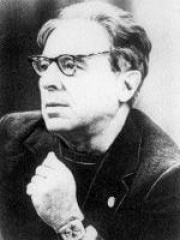
5. Iosif Shklovsky (1916 - 1985)
With an HPI of 60.39, Iosif Shklovsky is the 5th most famous Ukrainian Astronomer. His biography has been translated into 28 different languages.
Iosif Samuilovich Shklovsky (sometimes transliterated Josif, Josif, Shklovskii, Shklovskij; Russian: Ио́сиф Самуи́лович Шкло́вский; 1 July 1916 – 3 March 1985) was a Soviet astronomer and astrophysicist. He is remembered for his work in theoretical astrophysics and other topics, as well as for his 1962 book on extraterrestrial life, the revised and expanded version of which was co-authored by American astronomer Carl Sagan in 1966 as Intelligent Life in the Universe. He won the Lenin Prize in 1960 and the Bruce Medal in 1972. Asteroid 2849 Shklovskij and the crater Shklovsky (on the Martian moon Phobos) are named in his honor. He was a Corresponding Member of Soviet Academy of Sciences since 1966.

6. Klim Churyumov (1937 - 2016)
With an HPI of 59.36, Klim Churyumov is the 6th most famous Ukrainian Astronomer. His biography has been translated into 21 different languages.
Klim Ivanovich Churyumov (Ukrainian: Клим Іванович Чурюмов; 19 February 1937 – 14 October 2016) was a Soviet and Ukrainian astronomer. He was the director of the Kyiv Planetarium, a member of the National Academy of Sciences of Ukraine and the International Astronomical Union, of the New York Academy of Sciences, the editor of the magazine Our Skies (Ukrainian: Наше Небо) in 2006–2009, the president of the Ukrainian Society of amateur astronomy and the author of books for children. In 1969, he discovered, with Svetlana Gerasimenko, the comet 67P/Churyumov–Gerasimenko; on 12 November 2014, the Rosetta space mission landed its Philae spacecraft on its surface.

7. Viktor Knorre (1840 - 1919)
With an HPI of 58.02, Viktor Knorre is the 7th most famous Ukrainian Astronomer. His biography has been translated into 20 different languages.
Viktor Karlovich Knorre (Russian: Виктор Карлович Кнорре; 4 October 1840 – 25 August 1919) was a Russian astronomer of German origin. He worked in Nikolaev, Pulkovo and Berlin and is best known for having discovered 158 Koronis and three other minor planets. Knorre's father, Karl Friedrich Knorre, and grandfather, Ernst Friedrich Knorre, were also prominent astronomers. Recently, the main-belt asteroid 14339 Knorre was named in honor of the three generations of Knorre astronomers.

8. Grigory Shajn (1892 - 1956)
With an HPI of 56.75, Grigory Shajn is the 8th most famous Ukrainian Astronomer. His biography has been translated into 20 different languages.
Grigory Abramovich Shajn (Russian: Григорий Абрамович Шайн) (April 19, 1892 – August 4, 1956) was a Soviet/Russian astronomer. In modern English transliteration, his surname would be given as Shayn, but his astronomical discoveries are credited under the name G. Shajn. Nonetheless, his last name is sometimes given as Schayn. He earned a masters degree from Tomsk University in 1920. He was the husband of Pelageya Shajn (Пелагея Фёдоровна Шайн) née Sannikova (Санникова), who was also a Russian astronomer. He worked on stellar spectroscopy and the physics of gaseous nebulas. Together with Otto Struve, he studied the rapid rotation of stars of young spectral types and measured the radial velocities of stars. He discovered new gaseous nebulas and the anomalous abundance of 13C in stellar atmospheres. He became a member of the Soviet Academy of Sciences in 1939, and was also a member of various foreign societies such as the Royal Astronomical Society. From 1945 to 1952 he was the director of the Crimean Astrophysical Observatory. In 1947, he was elected a Fellow of the American Academy of Arts and Sciences and received an honorary doctorate from the University of Copenhagen. He also discovered a few asteroids. He also co-discovered the non-periodic comet C/1925 F1 (Shajn-Comas Solá), also known as Comet 1925 VI or Comet 1925a. However, the periodic comet 61P/Shajn–Schaldach was co-discovered by his wife rather than by him. The crater Shayn on the Moon is named after him. He and his wife were also honoured by the minor planet 1648 Shajna.
People
Pantheon has 8 people classified as Ukrainian astronomers born between 1831 and 1945. Of these 8, none of them are still alive today. The most famous deceased Ukrainian astronomers include Svetlana Gerasimenko, Otto Struve, and Tamara Smirnova.
Deceased Ukrainian Astronomers
Go to all RankingsSvetlana Gerasimenko
1945 - 2025
HPI: 67.19
Otto Struve
1897 - 1963
HPI: 64.04
Tamara Smirnova
1935 - 2001
HPI: 62.41
Fyodor Bredikhin
1831 - 1904
HPI: 61.35
Iosif Shklovsky
1916 - 1985
HPI: 60.39
Klim Churyumov
1937 - 2016
HPI: 59.36
Viktor Knorre
1840 - 1919
HPI: 58.02
Grigory Shajn
1892 - 1956
HPI: 56.75
Overlapping Lives
Which Astronomers were alive at the same time? This visualization shows the lifespans of the 7 most globally memorable Astronomers since 1700.

